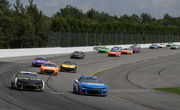
USA Today via Reuters
Nov 22, 2015; Homestead, FL, USA; Chase finalists and NASCAR Sprint Cup Series drivers from left Jeff Gordon (left) , Kevin Harvick , Martin Truex Jr and Kyle Busch stand next to the Sprint Cup championship trophy before the Ford EcoBoost 400 at Homestead-Miami Speedway. Mandatory Credit: Mark J. Rebilas-USA TODAY Sports

USA Today via Reuters
Nov 22, 2015; Homestead, FL, USA; Chase finalists and NASCAR Sprint Cup Series drivers from left Jeff Gordon (left) , Kevin Harvick , Martin Truex Jr and Kyle Busch stand next to the Sprint Cup championship trophy before the Ford EcoBoost 400 at Homestead-Miami Speedway. Mandatory Credit: Mark J. Rebilas-USA TODAY Sports
2023 was a year marked by farewells and finales in NASCAR. Kevin Harvick‘s departure from the scene was a particularly poignant moment for fans, striking a chord with many. Despite hanging up his helmet at 48, there’s a widespread belief among NASCAR aficionados that the former SHR ace still has fuel left in his tank for more racing. Amidst this backdrop of retirements, Kenny Wallace turned to Elliott Sadler for insights. Sadler’s take on why today’s drivers are bowing out earlier was quite thought-provoking.
According to Elliott Sadler, the reason boils down to the mounting stress and the way modern drivers’ bodies are conditioned. Unlike the seasoned racers of yesteryears, today’s drivers, he suggests, aren’t built to endure the rigors of racing into their later years. This shift in physical resilience is prompting a trend of earlier retirements in NASCAR.
ADVERTISEMENT
Article continues below this ad
Elliott Sadler ponders the rising trend of early retirement in NASCAR
Going back to 2020, we saw Jimmie Johnson‘s notable exit from the circuit at 47. Fast forward to recent times, and we’ve seen Kevin Harvick and Aric Almirola hanging up their helmets at 48 and 39, respectively. Though Almirola’s tale is a different one and rumors say that he might be back in 2024, he did announce his retirement pretty early. There was even speculation about 42-year-old Martin Truex Jr joining the retirement bandwagon, but his solid performance this season might have put those rumors to bed.
Watch This Story: The $75,000 Legacy – Dale Earnhardt’s priceless memorabilia
Kenny Wallace, curious about this trend of drivers bowing out earlier, posed a question about it. Elliott Sadler’s response hit the nail on the head: “I think stress has a lot to do with it. Stress in our sport is so bad. It’s tough. Some of us know how to cope with it with different ways and things like that. […] I think people get tired of it. Your brother and..[…],Dale, Jared, and Bill Elliott, I just think they were a different breed of tough guys. They could race to 50/51. I must don’t know if we have anybody wired that way that can go to that age anymore. Harvick was to me and was the last of the tough guys. You know, he went a long way.”
Interestingly, Kenny Wallace himself had offered a similar perspective back in August, shedding light on this shift in the racing realm.
ADVERTISEMENT
Article continues below this ad
Trending
Kenny Wallace’s take on why drivers are retiring early
Kenny Wallace presented a multifaceted view of why drivers are hanging up their helmets earlier these days. First up, he pointed to sponsorships as a pivotal factor. In the cutthroat world of racing, if a driver can’t secure the necessary funding, they’re at risk of losing their seat. Wallace cited the case of Clint Bowyer, who faced challenges in his final years due to sponsorship woes.
Then there’s the lure of TV contracts. For drivers who’ve been in the doldrums in the latter part of their careers, the opportunity to transition to television is often too tempting to pass up. Lastly, Wallace highlighted the evolving nature of driving styles. Today’s drivers are notably more aggressive, leaving some of the old guard feeling out of sync with the sport’s current trajectory. This change in competitive ethos coincides with a shift in when racers typically start their careers.
ADVERTISEMENT
Article continues below this ad
So, between Kenny Wallace’s sponsorship, TV contracts, and changing driving styles, and Elliott Sadler’s emphasis on stress and physical endurance, which explanation resonates more with you?
ADVERTISEMENT
ADVERTISEMENT
ADVERTISEMENT
ADVERTISEMENT






